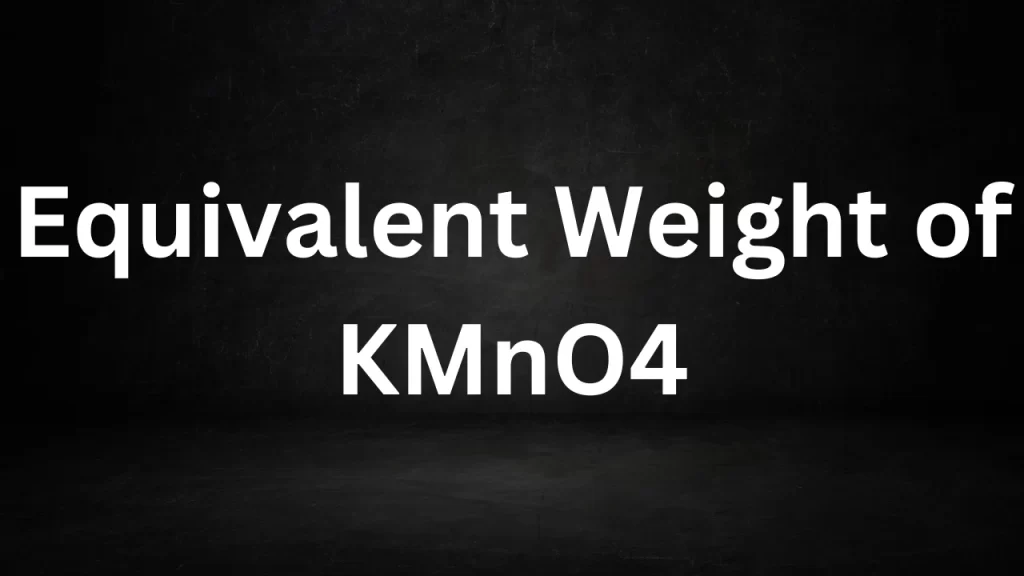Equivalent Weight of KMnO4
Equivalent Weight of KMnO4: Potassium permanganate, with the chemical formula KMnO4, is a powerful and versatile oxidizing agent commonly used in chemistry, medicine, and water treatment.
One of the key concepts related to potassium permanganate is its equivalent weight. In this article, we will explore the equivalent weight of KMnO4 and its significance in redox (reduction-oxidation) reactions.

Equivalent Weight of KMnO4
Understanding Equivalent Weight
Equivalent weight is a concept in chemistry that represents the mass of a substance (in this case, KMnO4) that can either gain or lose one mole of electrons during a chemical reaction.Put more simply, it informs us about the quantity of a substance required to either react with or substitute a specific quantity of electrons. Equivalent weight is particularly useful in redox reactions.
Atomic Composition of KMnO4
Before we calculate the equivalent weight of KMnO4, let’s understand its atomic composition:
- Potassium (K) has an atomic mass of approximately 39.10 grams per mole (g/mol).
- Manganese (Mn) has an atomic mass of approximately 54.94 g/mol.
- Oxygen (O) has an atomic mass of approximately 16.00 g/mol.
The molecular formula of potassium permanganate is KMnO4, which means it consists of one potassium atom (K), one manganese atom (Mn), and four oxygen atoms (O).
Calculating the Equivalent Weight of KMnO4
To calculate the equivalent weight of KMnO4, we need to determine how many moles of electrons one mole of KMnO4 can gain or lose during a redox reaction.
In a redox reaction, potassium permanganate (KMnO4) can undergo changes in its oxidation state. Specifically, manganese (Mn) can change from an oxidation state of +7 to +2 or lower. The quantity of electrons engaged in this transformation can be determined by subtracting the initial oxidation state (+2) from the final one (7), resulting in a total of 9 electrons.
Now, to find the equivalent weight, we divide the molar mass of KMnO4 by the number of electrons involved:
equ Weight of KMnO4 = Molar Mass of KMnO4 / Number of Electrons
equ Weight of KMnO4 = (39.10 g/mol + 54.94 g/mol + 4 × 16.00 g/mol) / 9 electrons
Equivalent Weight of KMnO4 ≈ 158.04 g/eq
Therefore, the equ weight of KMnO4 is approximately 158.04 grams per equivalent (g/eq).
Significance of equ Weight in Redox Reactions
The equ weight of KMnO4 is a critical parameter in redox reactions. It helps determine the quantity of KMnO4 required to react with a given amount of reducing agent or to oxidize a specific substance. In practical applications, chemists use equivalent weight calculations to balance redox equations and ensure that reactions proceed accurately.
Conclusion
The equ weight of KMnO4, approximately 158.04 grams per equivalent (g/eq), is a fundamental concept in redox chemistry. It defines the mass of KMnO4 that can either gain or lose one mole of electrons during a chemical reaction. Understanding the equivalent weight of KMnO4 is essential for accurately designing and conducting redox reactions in various fields, including analytical chemistry, environmental science, and industrial processes.
Read More
- Molecular Mass of Na
- Chemical Properties of Acid
- Molar Mass of Benzene
- Molar Mass of Calcium
- Electromagnetic Spectrum X Rays
Frequently Asked Questions (FAQs) equ Weight of KMnO4
What is the equ weight of KMnO4?
The equ weight of KMnO4 (potassium permanganate) is approximately 158.04 grams per equivalent (g/eq). It represents the mass of KMnO4 that can either gain or lose one mole of electrons during a redox (reduction-oxidation) reaction.
Why is equ weight important in redox reactions involving KMnO4?
Equ weight is a crucial concept in redox chemistry. It helps determine the quantity of KMnO4 needed to react with a specific amount of a reducing agent or to oxidize a particular substance accurately. It is essential for balancing redox equations and ensuring the proper stoichiometry of reactions.
How is the equ weight of KMnO4 calculated?
The equivalent weight of KMnO4 is determined by dividing its molar mass by the number of electrons participating in the redox alteration. In the case of KMnO4, the redox change typically involves manganese (Mn) changing from an oxidation state of +7 to +2 or lower, which corresponds to nine electrons.
What are some common applications of KMnO4 in chemistry?
KMnO4 is extensively employed as a powerful oxidizing agent in diverse chemical reactions. It used in titrations for determining the concentration of reducing agents, organic synthesis, and water treatment. It is also used as a disinfectant and stain remover.
Can you provide an example of how to use the equ weight of KMnO4 in a redox reaction?
Sure! Let’s say you have a redox reaction where you want to oxidize iron(II) ions (Fe²⁺) to iron(III) ions (Fe³⁺) using KMnO4. You would use the equ weight of KMnO4 to calculate the amount of KMnO4 required to oxidize a given amount of Fe²⁺. This calculation ensures that the reaction proceeds with the correct stoichiometry.